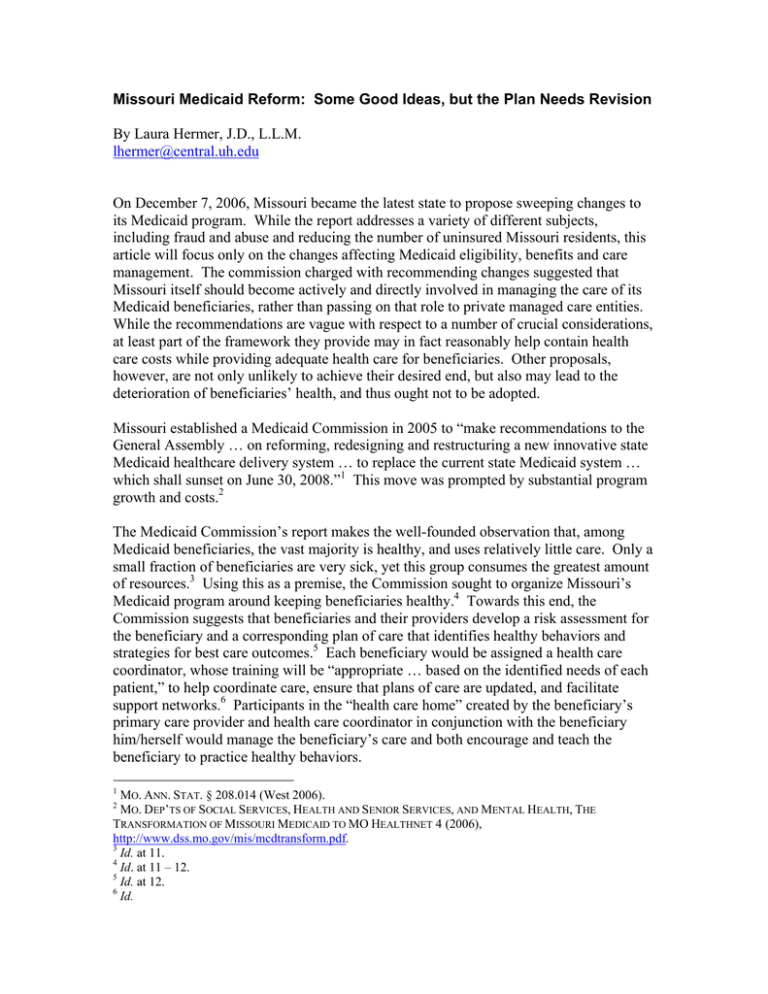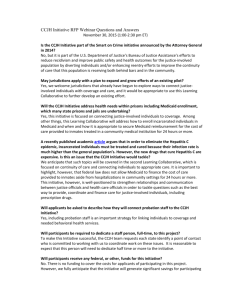Missouri Medicaid Reform: Some Good Ideas, but the Plan... By Laura Hermer, J.D., L.L.M.
advertisement

Missouri Medicaid Reform: Some Good Ideas, but the Plan Needs Revision By Laura Hermer, J.D., L.L.M. lhermer@central.uh.edu On December 7, 2006, Missouri became the latest state to propose sweeping changes to its Medicaid program. While the report addresses a variety of different subjects, including fraud and abuse and reducing the number of uninsured Missouri residents, this article will focus only on the changes affecting Medicaid eligibility, benefits and care management. The commission charged with recommending changes suggested that Missouri itself should become actively and directly involved in managing the care of its Medicaid beneficiaries, rather than passing on that role to private managed care entities. While the recommendations are vague with respect to a number of crucial considerations, at least part of the framework they provide may in fact reasonably help contain health care costs while providing adequate health care for beneficiaries. Other proposals, however, are not only unlikely to achieve their desired end, but also may lead to the deterioration of beneficiaries’ health, and thus ought not to be adopted. Missouri established a Medicaid Commission in 2005 to “make recommendations to the General Assembly … on reforming, redesigning and restructuring a new innovative state Medicaid healthcare delivery system … to replace the current state Medicaid system … which shall sunset on June 30, 2008.”1 This move was prompted by substantial program growth and costs.2 The Medicaid Commission’s report makes the well-founded observation that, among Medicaid beneficiaries, the vast majority is healthy, and uses relatively little care. Only a small fraction of beneficiaries are very sick, yet this group consumes the greatest amount of resources.3 Using this as a premise, the Commission sought to organize Missouri’s Medicaid program around keeping beneficiaries healthy.4 Towards this end, the Commission suggests that beneficiaries and their providers develop a risk assessment for the beneficiary and a corresponding plan of care that identifies healthy behaviors and strategies for best care outcomes.5 Each beneficiary would be assigned a health care coordinator, whose training will be “appropriate … based on the identified needs of each patient,” to help coordinate care, ensure that plans of care are updated, and facilitate support networks.6 Participants in the “health care home” created by the beneficiary’s primary care provider and health care coordinator in conjunction with the beneficiary him/herself would manage the beneficiary’s care and both encourage and teach the beneficiary to practice healthy behaviors. 1 MO. ANN. STAT. § 208.014 (West 2006). MO. DEP’TS OF SOCIAL SERVICES, HEALTH AND SENIOR SERVICES, AND MENTAL HEALTH, THE TRANSFORMATION OF MISSOURI MEDICAID TO MO HEALTHNET 4 (2006), http://www.dss.mo.gov/mis/mcdtransform.pdf. 3 Id. at 11. 4 Id. at 11 – 12. 5 Id. at 12. 6 Id. 2 Missouri’s management of the care of each beneficiary would go beyond the establishment of a medical home for Medicaid recipients. Providers in the program would have electronic access to all of each patient’s medical records from all providers and prescription information.7 Access to the patient’s complete records would be essential in developing and updating thorough and reliable plans of care. Providers also would have access to use “best practice” information, though the report gives no information about how it might structure this feature of practice.8 As an incentive to participate, the report proposes raising reimbursement rates for physicians acting as health care home providers to those offered under Medicare, and additionally would offer performance incentives, starting with certain health care home providers with a large chronic care caseload who both met evidence-based measures and adhered to their patients’ plans of care. Despite their lack of detail, these features are the most promising of the report’s recommendations. If implemented reasonably, they have the potential to help defragment and coordinate the care received by Medicaid patients while both helping to limit waste (e.g., duplicated or irrelevant tests) and encouraging provider participation through more generous reimbursement. Because the state itself would implement the plan as conceived in the report, savings would accrue directly to the state, and could be used to improve coverage, raise provider reimbursements, or reduce taxes, among other possibilities. Other aspects, however, are less promising. Most notably, the report suggests that the revamped Medicaid program would provide only basic benefits to recipients. The receipt of further benefits, such as “dental,” would be contingent on “liv[ing a] healthy lifestyle.”9 Unfortunately, it’s impossible to tell for sure, as the report entirely omits any mention of the benefits that would be included in the new plan (other than the aforementioned “dental”).10 The proposed withholding of benefits as a stick to “encourage” healthy behaviors from participants is a strategy apparently finding much favor among some states with newly-revamped Medicaid programs.11 Missouri ought not to withhold necessary benefits, only to bestow them on certain classes of individuals in exchange for providing evidence of healthy behaviors. As a strategy, it is both punitive and paternalistic. Yet even more significant for a state revamping its Medicaid program in part to improve the health of its beneficiaries, it is poorly calculated to lead to anything other than a diminution of the health status of many Medicaid recipients. As Gene Bishop and Amy Brodkey noted, it is difficult to imagine how, for 7 Id. at 13. Id. The Appendix to the report defines the practice of evidence-based medicine as the integration of “individual clinical expertise with the best available external clinical evidence from systematic research,” but says nothing more about it. Id. at Appendix A. 9 Id. at 14. 10 Despite several attempts, no one at the state Division of Medical Services was able to tell me what benefits would be included in the basic package or what would be offered as supplemental benefits. 11 West Virginia currently offers the most striking example of such a plan. See letter from Dennis G. Smith, Director, Centers for Medicaid and State Operations, to Nancy Atkins, Commissioner, Bureau for Medical Services, May 3, 2006 (State Plan Amendment, section 3.1, Attachment 2). 8 example, taking away mental health benefits from a depressed Medicaid beneficiary for having failed to meet certain targets could possibly contribute to the beneficiary’s wellbeing or ultimate independence.12 While it could be argued that patient compliance is necessary to help ensure the success of a health system based on following a plan of care and using evidence-based medicine, it is unfortunate for a variety of reasons that the state would choose to use negative reinforcement to make patients take certain actions, rather than a form of the positive reinforcement the same report would offer to providers for participation. December 2006 12 Gene Bishop & Amy C. Brodkey, Personal Responsibility and Physician Responsibility — West Virginia's Medicaid Plan, 355 N. ENG. J. MED. 756 (2006).



